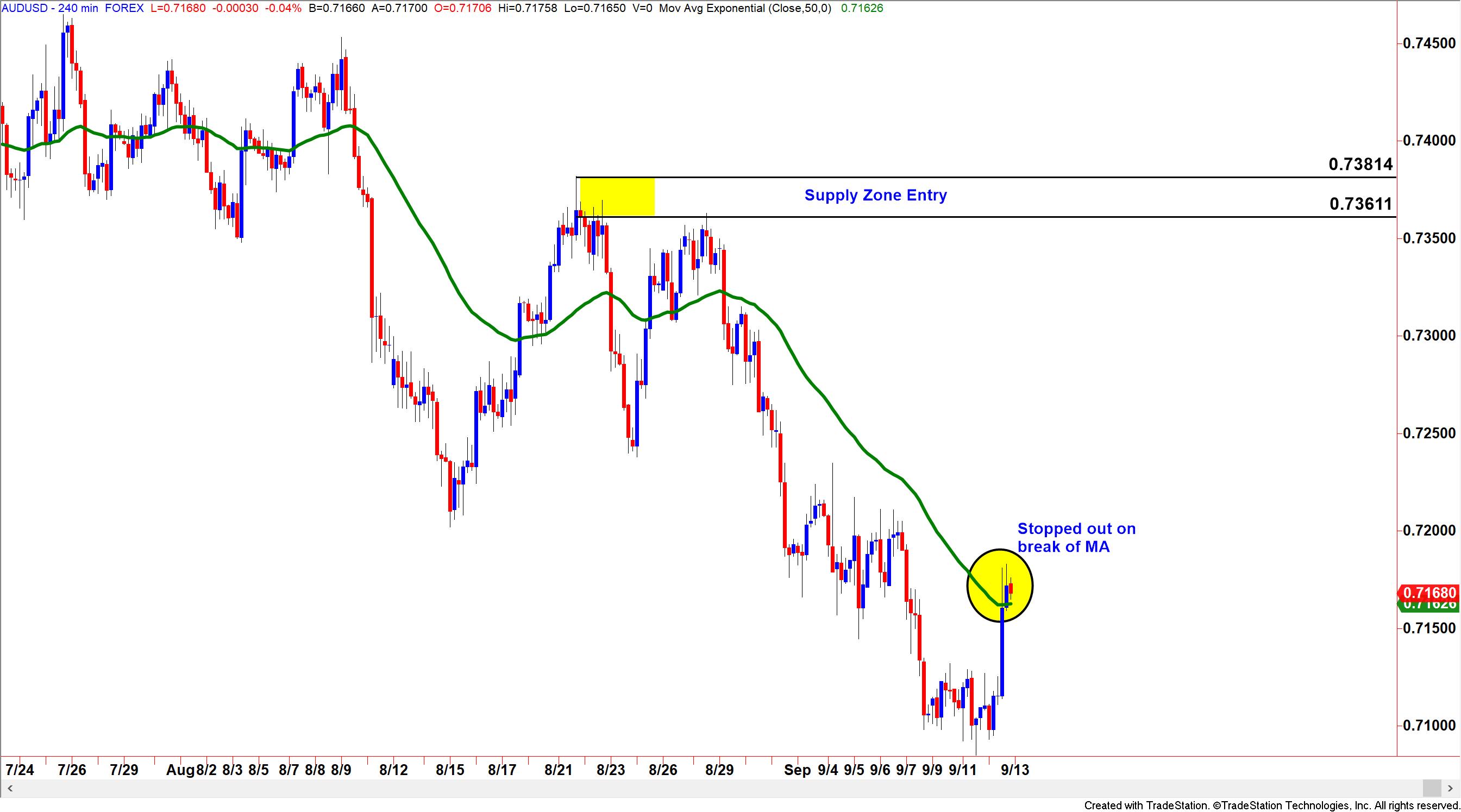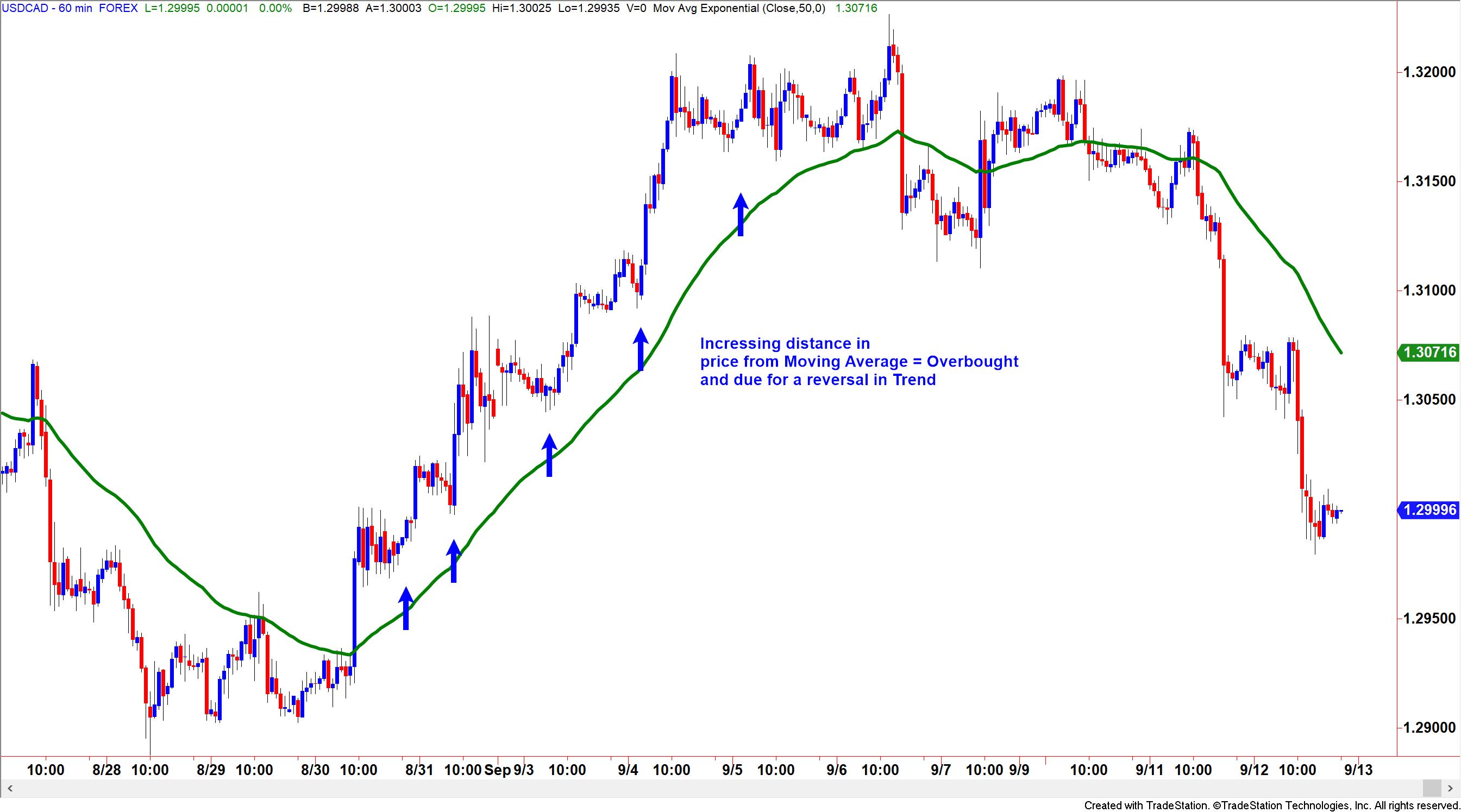Here at Online Trading Academy, we follow a strict rule-based core strategy. Most other forms of education today tend to focus on traditional theories of technical analysis, whereas we focus on price alone. Price is dependent on the laws of supply and demand, which in turn helps us to build an understanding of what institutional order flow is and how it works across the Forex markets. When you can recognize buying and selling activity and you know what its picture looks like on a price chart, you will understand what the true areas of supply or demand look like. A focus on price allows me to keep my trading simple, yet there are times when technical indicators can also be used as a filtering tool. My personal choice would be the Moving Average, also known as the MA.
What is the Moving Average?
The MA is a simple tool which measures the average price of an asset over a set period of time and is one of the earliest tools found in Technical Analysis studies. They are fairly useful too, and can be used in the following manner:
-
To define a trend
-
For entries and exits
-
For a trailing Stop Loss
-
To highlight when markets are overbought and oversold
Like any technical tool though, we must understand that there are always pros and cons to using the moving average. Understanding what supply and demand looks like on a price chart before using any other analysis too is key, as pure price action always comes first. If we do respect price though, there is no reason why we can’t use a moving average to aid us in our trading. Let’s take a look at these four uses in a little more detail.
In this example I have used a 50-period moving average.
The 50-period moving average is a good setting to use when attempting to define a trend in the marketplace. Can you see how prices on the candlesticks are clearly trading above the Moving Average? This confirms the upward trend. With the trend confirmed, the trader can then focus on buying into this trend. However, what the moving average won’t tell you is when that trend is going to come to an end, as we can see on the right-hand side of the picture. That is why you have to understand what a supply zone looks like and a demand zone looks like, because they are the areas where the trend would likely reverse and the moving average will always be too late to give us this information.
Some people use the Moving Average as a kind of dynamic support and resistance area to enter trades long and short when the price touches the MA. This approach does not use price as the primary decision-making tool, however, and can give many false signals along the way, especially in a ranging market like the one above. While this technique can be used from time to time in a trending market, a smarter approach would be to isolate an entry using supply and demand zones with a Moving Average as backup only.
One of the things I like about moving averages, is that they can be used when you’re already in a trade as a fantastic tool to maximize your profit potential. In the above example, we can see how after taking a trade at one of our supply zones, we then used the moving average to trail the stop technically. The rule employed was to close out the trade when the candlestick closed above the moving average. Using this technique in a rule-based trading plan can be a very objective method to take profit. As we all know, taking profits can be a real challenge for many traders, making them question whether they should get out or stay with the trade when it is working out for them. By using the moving average, this takes the thought process out and relies instead upon a simple objective rule, thus eliminating the emotions.
Finally, the MA is a great way to measure conditions in the market when prices are overbought and oversold. In the above example, we can see prices moving in a parabolic fashion away from the moving average. Notice how steep the rise is in the candlesticks? The moving average is trading well behind the candles themselves with the distance increasing between the moving average line and the bodies of the candles. This shows us an overextension in price or an overbought situation. The reverse would be true in a downward trend.
The further the candlestick moves away from the moving average, the more likely that this price trend is unsustainable. Prices are moving at a far greater rate away from their average than is sustainable. During these market conditions we would expect a currency pair to reverse at a sharp rate when confronted with a major level of supply or demand. The moving average helps in showing us when markets are going parabolic and when this movement is difficult to maintain.
In conclusion, I would like to stress once again that if you decide to use a technical indicator in your trading toolkit, then make sure that you use the indicator in an objective way. One of the many reasons why I like moving averages is because they provide us with many different functions, all of which are not reliant on giving buying and selling signals. For that, I have price and supply and demand. I hope you found this useful.
Read the original article here - Using a Moving Average with Core Strategy
Note: All information on this page is subject to change. The use of this website constitutes acceptance of our user agreement. Please read our privacy policy and legal disclaimer. Opinions expressed at FXstreet.com are those of the individual authors and do not necessarily represent the opinion of FXstreet.com or its management. Risk Disclosure: Trading foreign exchange on margin carries a high level of risk, and may not be suitable for all investors. The high degree of leverage can work against you as well as for you. Before deciding to invest in foreign exchange you should carefully consider your investment objectives, level of experience, and risk appetite. The possibility exists that you could sustain a loss of some or all of your initial investment and therefore you should not invest money that you cannot afford to lose. You should be aware of all the risks associated with foreign exchange trading, and seek advice from an independent financial advisor if you have any doubts.
Editors’ Picks
EUR/USD clings to daily gains above 1.0650

EUR/USD gained traction and turned positive on the day above 1.0650. The improvement seen in risk mood following the earlier flight to safety weighs on the US Dollar ahead of the weekend and helps the pair push higher.
GBP/USD recovers toward 1.2450 after UK Retail Sales data

GBP/USD reversed its direction and advanced to the 1.2450 area after touching a fresh multi-month low below 1.2400 in the Asian session. The positive shift seen in risk mood on easing fears over a deepening Iran-Israel conflict supports the pair.
Gold holds steady at around $2,380 following earlier spike

Gold stabilized near $2,380 after spiking above $2,400 with the immediate reaction to reports of Israel striking Iran. Meanwhile, the pullback seen in the US Treasury bond yields helps XAU/USD hold its ground.
Bitcoin Weekly Forecast: BTC post-halving rally could be partially priced in Premium

Bitcoin price shows no signs of directional bias while it holds above $60,000. The fourth BTC halving is partially priced in, according to Deutsche Bank’s research.
Week ahead – US GDP and BoJ decision on top of next week’s agenda

US GDP, core PCE and PMIs the next tests for the Dollar. Investors await BoJ for guidance about next rate hike. EU and UK PMIs, as well as Australian CPIs also on tap.
RECOMMENDED LESSONS
Making money in forex is easy if you know how the bankers trade!
Discover how to make money in forex is easy if you know how the bankers trade!
5 Forex News Events You Need To Know
In the fast moving world of currency markets, it is extremely important for new traders to know the list of important forex news...
Top 10 Chart Patterns Every Trader Should Know
Chart patterns are one of the most effective trading tools for a trader. They are pure price-action, and form on the basis of underlying buying and...
7 Ways to Avoid Forex Scams
The forex industry is recently seeing more and more scams. Here are 7 ways to avoid losing your money in such scams: Forex scams are becoming frequent. Michael Greenberg reports on luxurious expenses, including a submarine bought from the money taken from forex traders. Here’s another report of a forex fraud. So, how can we avoid falling in such forex scams?
What Are the 10 Fatal Mistakes Traders Make
Trading is exciting. Trading is hard. Trading is extremely hard. Some say that it takes more than 10,000 hours to master. Others believe that trading is the way to quick riches. They might be both wrong. What is important to know that no matter how experienced you are, mistakes will be part of the trading process.




